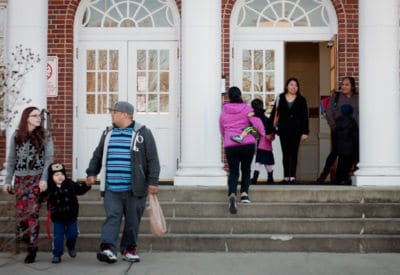Professional development.
Two words that bring a range of reactions — and facial expressions — to each meeting I’ve sat in with school staff members. Some immediately rock back in their chairs, eyebrows raised, wondering why I think some new opportunity is worth the time of teachers who already have more than enough on their plates. Some chime in immediately to voice their agreement, offering a flurry of ideas more quickly than I can write. Some may perk up when they hear my program’s funds might be able to assist with paying for substitute teachers when they miss class time, along with lunch for attendees, and any material costs associated with the training.
Schools are inundated with demands — from parents, students, staff, and government officials.
External, grant-funded programs like mine, which specifically focus on preventing youth violence and enhancing school climate, can offer some really wonderful opportunities for students and staff. Still, I always try to remind myself that we are placing demands on our schools.
On our end, we need to meet our grant objectives, serve a certain number of students, and provide training and professional development to teachers, all of which requires help and coordination on behalf of the school.
It has been tricky, and we have undoubtedly stumbled several times in attempting to figure out the “who, what, when, and where” of the different professional development opportunities we have offered since our grant began. I do believe that we’re getting there and I think it’s starting to show in terms of school climate, staff satisfaction, and our ultimate goal of positively impacting students.
So what have we done that’s worked?
First, and I believe most importantly, we asked teachers: “Do you want to know more about trauma and how it impacts yours students?”
We sent this question out in a survey that was completed by 200 local teachers, and 86 percent responded with a resounding “yes!”
From there, we started to create a menu of different options. These options included flexibility in the when’s (before, during, or after school, weekly, bi-weekly, monthly), the where’s (the school or the health department), and the who’s (full staff, student support only, individuals specifically selected by administrators).
After reading about and speaking with other districts who have begun the process of creating more trauma-sensitive schools, increasing awareness of and education about trauma, ACEs, and their prevalence and impacts on students, families, and school performance was the first key step into creating sustainable change.
In early spring 2016, I was invited to the North Carolina Public School Forum to learn about state and nationwide initiatives in regards to trauma sensitive schools. During one of the sessions, we were introduced to a wonderful resource, The Heart of Learning and Teaching. This (free!) downloadable PDF breaks down trauma-informed education into easily digested and manageable sections. I went home and devoured the book — twice — over the weekend. I reached out to our different principals and professional development coordinators and presented the book and some ideas I had for working with schools. Each school selected a different way of presenting this information to their staff, once again highlighting the absolute importance of having as many options as possible for schools to choose from.
One of our high schools dedicated a five week professional learning cluster series to this book. I created study guides and worked with all of the staff on a weekly basis for a little over a month. Staff were required to attend, which definitely has some pros and cons associated with it.
One of our middle schools decided to split their staff into groups of 15 with the goal that throughout this past spring and upcoming school year, all staff would cycle through the book study on a monthly basis during their after-school staff meetings.
Another middle school opted to make the book study optional for teachers, and about nine staff members would munch on Dunkin’ Donuts every other Friday at 7:15 in the morning while talking about what we saw playing out in the halls and classrooms that mirrored what the book outlined in regards to childhood trauma.
While the setups in terms of time, number of attendees, and frequencies varied from school to school, many of the stories, distress, and unsureness of what to say or when to say it when working with traumatized children were similar across the board.
The initial reactions to this learning series varied greatly. Some educators brought in external resources to share with the groups, completed the written guides in full detail, and shared their thoughts on what others schools were doing in regards to combatting their students ACEs and what components of these efforts could work at their own school. A few voiced their opinion that the goal of teachers first and foremost is to educate students in their assigned subject — math, English, science — and that this social-emotional learning was far out of their desired job duties; and that I would do best to remember that I have no idea what kind of pressures are placed on teachers regularly (this is very true). As we talked through these very real and understandable sentiments, many of us iterated over and over again how important this social learning is both in terms of the students’ mental well being as well as their academic success.
Regardless of the initial reactions, by the end of the series with each group, the reviews became increasingly positive and teachers shared that they saw the merit in learning more about this topic and how it applies in their own personal and professional lives.
We can control very few things in our schools and students’ lives.
We can’t control what kind of home they go home to every day.
We can’t control our colleagues’ interactions with students or ourselves.
But we can control one crucial piece of a student’s time at school: how did we make them feel?
Whether it is for the 90-minute block we have them in front of us or the after-school sports practice, theater group, or tutoring review, we have the opportunity to shape how the students feel about whether or not an adult is really invested in making their day a little bit better.
Teachers have an incredible power, and therefore responsibility, to ensure that their students are feeling listened to and cared for while also ensuring that subject matter is being taught. I fully recognize how difficult this task is and that it will not always be a smooth ride. But when I hear that a trauma-informed focus with students won’t get them ready for the “real world,” I have to question what kind of “real world” do we want for our kids? If we teach them that relationship building, empathy, and investing in others are all crucial components of being good human beings, we have a much better shot at creating a future for which they are more excited.
And that excitement just might translate into a better school and community environment for all of us.



